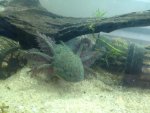VinnyMacC
New member
are long gills genetic or based on water quality?, available oxygen, ect...
I know axos can respire a few different ways, the question is will making the environment favorable to a certain form of respiration contribute to change.
*example; less oxygen in the water means axos cant get it from the water thru the gills nor skin ...so they inturn must "glup" more air..sideeffect gills are used less and energy is diverted else where?*
these guys seem to have an incredible ability to adapt/roll with the punches, not just sticking it out...but imbedded in their genes.
I know axos can respire a few different ways, the question is will making the environment favorable to a certain form of respiration contribute to change.
*example; less oxygen in the water means axos cant get it from the water thru the gills nor skin ...so they inturn must "glup" more air..sideeffect gills are used less and energy is diverted else where?*
these guys seem to have an incredible ability to adapt/roll with the punches, not just sticking it out...but imbedded in their genes.



